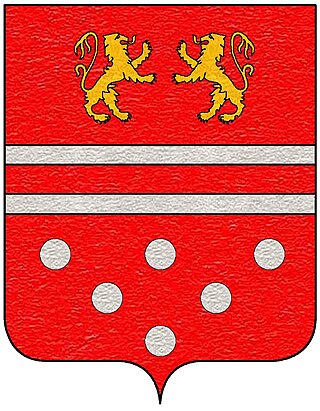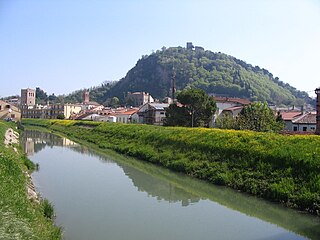Related Research Articles

Pope Innocent IV, born Sinibaldo Fieschi, was head of the Catholic Church and ruler of the Papal States from 25 June 1243 to his death in 1254.
Hugh of Evesham was a 13th-century English churchman, physician and alchemist. Given his name, it is likely that he came from Evesham, Worcestershire.
Giovanni Boccamazza was an Italian Cardinal. He was from the Roman nobility, and was a nephew of Cardinal Giacomo Savelli, who had been an important figure in the Roman Curia since his creation as cardinal in 1261.

The Annibaldi were a powerful baronial family of Rome and the Lazio in the Middle Ages. They began to rise to prominence in the 13th century with the favour of Popes Gregory IX and Alexander IV, in the vacuum left by the Counts of Tusculum. In the late years of the same century they were however overwhelmed by the Caetani.

Latino Malabranca Orsini was a Roman noble, an Italian cardinal of the Holy Roman Church, and nephew of Pope Nicholas III.
Pierre de Bar was a French Cardinal. He is also tentatively identified as a scholastic philosopher, at the University of Paris around 1230. Some sources indicate that he entered Cistercian Order but more recent research conclude that he was secular priest. He was chancellor of the diocese of Noyon from 1232 until his promotion to the cardinalate.
Gerardo Bianchi was an Italian churchman and papal diplomat, an important figure of the War of the Sicilian Vespers.

Jean Lemoine, Jean Le Moine, Johannes Monachus was a French canon lawyer, Cardinal, bishop of Arras and papal legate. He served Boniface VIII as representative to Philip IV of France, and founded the Collège du Cardinal Lemoine, in Paris. He is the first canon lawyer to formulate the legal principle of the presumption of innocence.
Niccolo Conti di Segni - Italian cardinal allegedly created by Pope Gregory IX with the title of San Marcello in the consistory of December 1228 and subsequently sent as papal legate to Armenia to mediate in the conflicts between king Hethum I of Armenia and the Principality of Antioch; king Hethum I considered him partial in favor of the Principality of Antioch and asked pope for his recalling. He is said to have died in 1239.

Agostino Paravicini Bagliani is an Italian historian, specializing in the history of the papacy, cultural anthropology, and in the history of the body and the relationship between nature and society during the Middle Ages.
The 1254 papal election took place following the death of Pope Innocent IV and ended with the choice of Raynaldus de' Conti, who took the name Pope Alexander IV. The election was held in Naples, in the former palazzo of Pietro della Vigna, and required only one day.

The 1261 papal election took place after the death of Pope Alexander IV on 25 May and chose Pope Urban IV as his successor. Since Pope Alexander had been resident in Viterbo since the first week of May 1261, the meeting of the cardinals to elect his successor took place in the Episcopal Palace at Viterbo, which was next to the Cathedral of S. Lorenzo. The actual date of the beginning of the Electoral Meeting is unknown. If the canon of Pope Boniface III were still in effect, then the Election could not begin until the third day after the Pope's burial.
Geoffroy de Bar or Barbeau, of Burgundy, was a French cardinal and member of the Roman Curia. He died in 1287.

Matteo Rosso Orsini, was a Roman aristocrat, politician, diplomat, and Roman Catholic Cardinal. He was the nephew of Pope Nicholas III (1277-1280).
Goffredo da Alatri, also called Goffredo di Alatri or Goffredo di Raynaldo, was an Italian nobleman, city leader and Roman Catholic cardinal. He was podestà of his native Alatri, a small town in the mountains, east of Anagni, in the last two years of his life.
Giordano Pironti dei Conti di Terracina was an Italian aristocrat, papal bureaucrat, and Roman Catholic Cardinal. His family included a brother, Pietro, and three nephews, Pietro, Giovanni and Paolo.

Guillaume de Bray was a French ecclesiastic and Roman Catholic Cardinal, poet, and mathematician.

Simone Paltanieri, son of Pesce Paltanieri, member of a distinguished family, was an Italian Roman Catholic cardinal.
Nicolas de Nonancourt. He was a French university Chancellor, Dean of a Cathedral, and Roman Catholic Cardinal.
Joannes was a 12th century Roman Catholic Cardinal, and Cardinal-priest of the titulus of Santa Cecilia in Trastevere in Rome. Alfonso Chacón writes that he was a member of the Capizucchi family, but he was deceived by the forgeries of Alfonso Ceccarelli, a contemporary acquaintance. In fact, according to Agostino Paravicini Bagliani, in the 11th and 12th centuries the Capizucchi family had no cardinals.
References
- ↑ In his Testament he identifies himself as "Petrus de Mediolano tituli Sancti Marci presbiter cardinalis": A. Paravicini Bagliani, I testamenti dei cardinali del Duecento (Roma 1980), pp. 56-58 and 272. Antoine Aubery, Histoire Generalle Des Cardinaux Volume 1 (Paris 1642), p. 345.
- ↑ Lorenzo Cardella, Memorie delle cardinali della Santa Romana Chiesa II (Roma 1792), p. 33.
- ↑ Descrizione sacra di Milano antico e moderno (Milano: Mazzuchelli, 1760), pp. 59-60.
- ↑ Giorgio Giulini, Memorie spettanti alla storia, al governo ed alla descrizione della città e della campagna di Milano ne' secoli bassi Parte VIII (Milano: G. B. Bianchi, 1760), p. 463. Is it Belviso de Pereg(ross)o ?
- ↑ Giancarlo Andenna, "Peregrosso, Pietro," Dizionario Biografico degli Italiani Volume 82 (2015).
- ↑ Julian Gardner, "French patrons abroad and at home: 1260-1300," in Rome Across Time and Space. Cultural Transmission and the Exchange of Ideas c. 500-1400 (ed. C. Bolgia, R. McKitterick and J. Osborne), p. 274. A. Paravicini Bagliani, I testamenti dei cardinali del Duecento (Roma 1980), p. cv. His Testament (Gardiner, p. 274 n. 34) says: Si vero me mori contigerit ultra montes in aliquot loco, ubi beneficiatus sum, videlicet Parisius, Lauduni vel Cameraci, tunc in ecclesia cathedral ipsius civitatis, in qua me mori contigerit ipsam meam eligo sepulturam.
- ↑ Angelo Mercati, "I codici di Cristoforo Tolomei...," p. 12.
- ↑ Giovanni Ciampini, De sanctae Romanae Ecclesiae Vicecancellario (Rome 1697), pp. 31-71.
- ↑ Augustus Potthast, Regesta pontificum Romanorum II (Berlin 1875), p. 1718.
- ↑ Thomas Rymer, Foedera, Conventiones, Literae et cujuscunque generis Acta Publica II (London: Churchill 1725), p. 287 (4 October 1284).
- ↑ Luca Wadding, Annales Minorum V, second edition by Joseph Maria Fonseca of Evora (Rome 1733), p. 73, under the year 1279, § x.
- ↑ Conradus Eubel, Hierarchia catholica medii aevi I, editio altera (Monasterii 1913), p. 11.
- ↑ E. Langlois, Les registres de Nicolas IV Tome I (Paris 1905), p. 95 no. 512.
- ↑ Eubel, p. 11 and p. 44. The promotion most probably took place on the Ember Saturday of December 18, 1288. Church of S. Marco, Rome.
- ↑ Potthast, no. 22744 (15 June 1288); and cf. nos. 22787 and 22803, which authorizes Cardinal Giacomo Savelli and two bishops to intervene in the case of the Humiliati immediately.
- ↑ Hieronymus Tiraboschi, Vetera Humiliatorum monumenta Volume I (Milan 1766), p. 90. Maria Pia Alberzoni, Annamaria Ambrosioni, Alfredo Lucioni (editors), Sulle tracce degli Umiliati (Milano: Vita e Pensiero, 1997), p. 293. Cf. E. Langlois, Les registres de Nicolas IV Tome I (Paris 1905), p. 599, no. 4059 (31 January 1291).
- ↑ Augustinus Theiner (Editor), Caesaris S. R. E. Cardinalis Baronii, Od. Raynaldi et Jac. Laderchii Annales Ecclesiastici Tomus Vicesimus Quintus, 1286-1312 (Barri-Ducis: Ludovicus Guerin 1871), under the year 1294 § 6, p. 131. Augustus Potthast, Regesta pontificum Romanorum II (Berlin 1875), p. 1915 (July 5, 1294)
- ↑ Bartholomeus de Cotton, Historia Anglicana (ed. H.R.Luard, London, 1859), pp. 256-257.
- ↑ Johann Peter Kirsch, Die Finanzverwaltung des Kardinalkollegiums im XIII. und XIV. Jahrhundert (Münster 1895), p. 44. The date on which he commenced the office is unknown. His only known predecessor, Cardinal Guillaume de Bray, died in 1282; there must have been at least one other cardinal between Guillaume and Pietro.
- ↑ Kirsch, p. 97.
- ↑ Potthast, no. 24106 and p. 2024: cum per me non possem, per Petrum Bonaegentis capellanum meum me subscripsi ('since I was not able personally, I signed through Pietro Bonaegentis my chaplain').
- ↑ Mercati, p. 12. A. Paravicini Bagliani, I testamenti dei cardinali del Duecento (Roma 1980), pp. 56-58 and 271-272.
- ↑ Lorenzo Cardella, Memorie delle cardinali della Santa Romana Chiesa II (Roma 1792), p. 33.
- ↑ Arnalda Dallaj and Maria Pia Alberzoni, Il Francescanesimo in Lombardia: storia e arte (Milano: Silvana, 1983). p. 345.
- ↑ Giorgio Giulini, Memorie spettanti alla storia, al governo ed alla descrizione della città e della campagna di Milano ne' secoli bassi Parte VIII (Milano: G. B. Bianchi, 1760), p. 462.